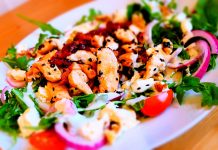
Your gut instinct to not believe the weight loss claims are sound.
I’ve read the brochure and sheet about Herbalife products. They contain numerous erroneous statements about nutrition and how your body uses nutrients. In this space, I will only address some of their fallacies in quotes.
Statements such as Formula No 1: Protein food “is scientifically formulated to satisfy your hunger and help reduce nervousness and irritability, which often comes when restricting food intake. It burns fat and builds muscle.” The role of protein is to build and repair lean tissue (muscles and organs). The building occurs during periods of growth, pregnancy, breastfeeding, or weightlifting exercise which increases muscle size. Protein does not burn fat in food or fat stored in the body.
In healthy adults, the Recommended Dietary Allowance (RDA) for protein (50 grams for adult females, 63 grams for adult males) is necessary to repair organs and muscle. Protein takes about 4 hours to digest then absorb into the body and will satisfy hunger by providing calories, but it does not reduce nervous irritability. In fact, a diet high in protein which causes ketosis is nauseating. That is why your appetite reduces while on a high protein diet. The idea that protein burns fat is simply not true. In starvation diets of less than 600 calories, your body will start breaking down muscle along with mobilizing some stored body fat. Your body will use protein for repair only if there are sufficient food calories available for fuel. Also, any excess consumed protein will be stored as body fat. Your body stores very little protein (i.e. proteins in the blood) other than what is found in muscle and organs (lean tissue).
The next claim is the Formula No 2 Herbs “curb the appetite and cleanse the body of toxins. It is the buildup of toxins that invites disease.” I have never read any scientific research to prove that herbs do anything to affect your appetite. Herbs do enhance the flavor of food. Your liver cleanses your body of toxins, (alcohol is a toxin). To suggest that herbs will rid your body of toxins that invite disease is unfounded. Your kidneys also remove waste from your body in urine and your intestines remove waste as stool. It further suggests that this herb formula will prevent disease. Research has substantiated that a wide variety of foods, adequate sleep, no smoking, no alcohol, a healthy weight, and exercise are best to prevent long-term diseases such as diabetes, heart disease, stroke, and cancer.
Another erroneous statement is that Formula No 4 Oil “contains essential fatty acids that our bodies need in order to assimilate protein. They keep the skin tight while losing weight and maintains your energy level throughout the day.” Corn, safflower, soybean, sunflower, cottonseed oils and margarine all contain the essential fatty acid, linoleic acid. At a minimum, you need about 1 teaspoon of oil or margarine per day to prevent fatty acid deficiency, which symptom is red, dry, flaky skin. In amounts above that level, your body uses fat to supply fuel to your body and carry fat-soluble vitamins (A, D, E, K) in food. Excess food fat is stored as body fat. Fat is not needed to assimilate protein. However, protein foods contain anywhere from 3 grams fat (1/2 teaspoon fat) per ounce to 8 grams fat (1 1/2 teaspoons fat) per 1 ounce of meat. A high protein diet is a high-fat diet. Enough calories from either fat or carbohydrates over basal energy needs are necessary for your body to spare food protein to build and repair muscle and organ tissue. However, as a fuel source, only 30% of fat can be converted into glucose to fuel the body.
Fat is digested and absorbed in about 6 hours which adds to your feeling full longer (satiety) and helps maintain energy (fuel) by providing additional calories to the body. Too much fat and you may feel sleepy or lethargic.
In regard to keeping your skin tight, collagen helps to keep the appearance of skin smooth. Collagen is higher in the skin of children and decreases with age. Anything you eat or rub (i.e. collagen) into the skin will not make it tighter or smoother. If you eat collagen (an example is gelatin desserts like Jello), it is digested into amino acids which are used by the body as fuel in low carbohydrate diets. As you age, your skin loses some elasticity as evidenced by wrinkles in our senior population.
Another concern I have regarding Herbalife Slim and Trim is its price. These liquid diets cost money and depending on the number of glasses per day you drink, the cost goes up. Most companies figure the price based on a per week or per month. You can compare that to the cost to how much you spend per week or per month on groceries. You can buy a lot of healthy whole grains, vegetables, fruits and low-fat dairy instead of what you would spend on liquid diets.
Lastly, a concern I have is that the diet claims it “will help you lose 10 to 29 pounds a month”, which is too much too fast. A practical weight loss plan based on the exchange list would be about 4 to 8 pounds a month depending on how many calories you were eating before going on a weight loss plan compared to how fewer calories you are eating to lose weight. The exchange list is a weight loss plan you can live with for the rest of your life, are more likely to stick to and help you reach your weight goal. The biggest concern I have about the Herbalife weight control program is that it doesn’t tell you what to eat after you’ve lost weight to keep it off. After reaching your goal weight, you can follow a weight maintenance plan based on the exchange list for the rest of your life and it won’t require you to buy liquid diets, special foods, or eliminate whole food groups like grains, fruits, or milk.
If you would like to read more about separating nutrition fact from fallacy, read “Food Facts Talk Back” from the Academy of Nutrition and Dietetics in your local library.


